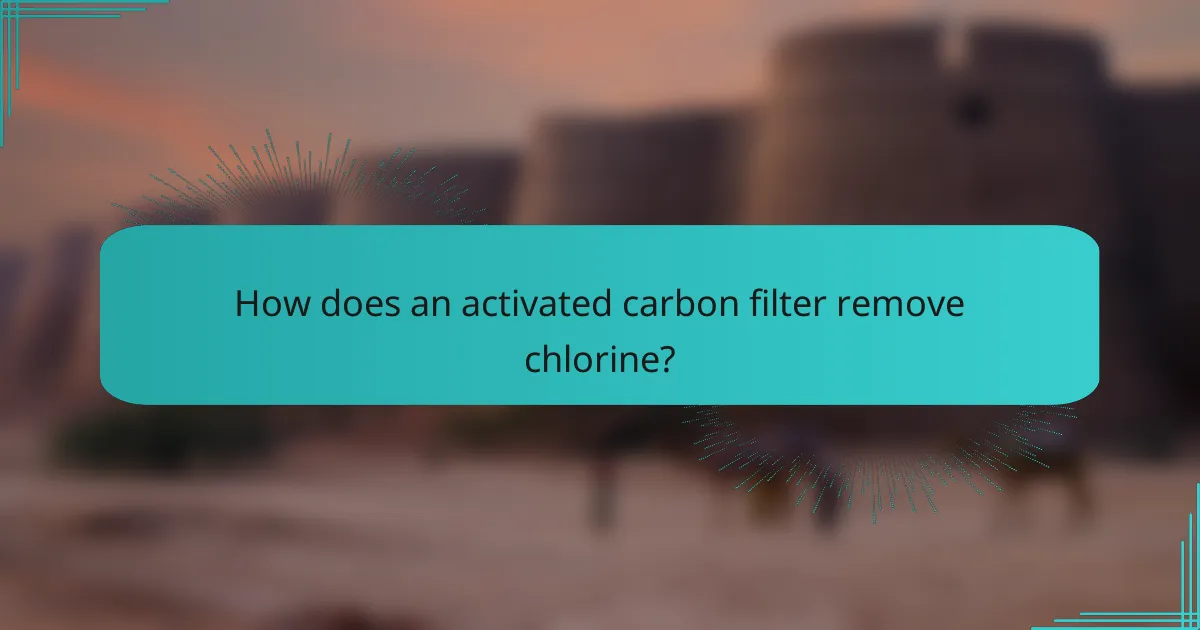An activated carbon filter effectively removes chlorine from water through adsorption, where chlorine molecules cling to the carbon granules. This process not only eliminates unpleasant tastes and odors but also significantly improves the overall quality of drinking water. Additionally, these filters are designed for easy installation, making them an ideal solution for enhancing water taste in both homes and businesses.

How does an activated carbon filter remove chlorine?
An activated carbon filter removes chlorine through a process called adsorption, where chlorine molecules adhere to the surface of the carbon granules. This method not only eliminates chlorine but also enhances the taste and odor of water, making it more palatable for consumption.
Adsorption process
The adsorption process involves the attraction of chlorine molecules to the porous surface of activated carbon. As water passes through the filter, chlorine is trapped within the tiny pores, effectively reducing its concentration in the water. This process is highly efficient due to the large surface area of activated carbon, which can be several hundred square meters per gram.
Activated carbon filters can vary in size and design, but they generally consist of granules or blocks of carbon. The effectiveness of adsorption depends on factors such as contact time, temperature, and the concentration of chlorine in the water.
Effectiveness against chlorine
Activated carbon filters are particularly effective at removing chlorine, often achieving reductions of over 90%. The effectiveness can vary based on the type of carbon used and the specific design of the filter. For optimal results, it is recommended to replace the filter regularly, typically every 6 to 12 months, depending on water quality and usage.
Testing the water before and after filtration can provide insights into the filter’s performance. Many home testing kits are available to measure chlorine levels, ensuring that the filter is functioning as intended.
Comparison with other filtration methods
When compared to other filtration methods, activated carbon filters excel in removing chlorine and improving taste. For instance, reverse osmosis systems can also remove chlorine but are generally more expensive and require more maintenance. In contrast, activated carbon filters are easier to install and maintain.
Other methods like sediment filters or UV purification do not specifically target chlorine removal. Therefore, for households focused on chlorine reduction and taste improvement, activated carbon filters are often the most practical choice.

What are the benefits of using an activated carbon filter?
Activated carbon filters offer several advantages, including the removal of chlorine and other impurities, which significantly enhances water taste and odor. They are also easy to install, making them a practical choice for improving water quality in homes and businesses.
Improved taste and odor
One of the primary benefits of activated carbon filters is their ability to improve the taste and odor of water. By effectively removing chlorine and other volatile compounds, these filters provide a fresher and more palatable drinking experience. Many users report a noticeable difference in flavor, making hydration more enjoyable.
To maximize taste improvement, consider using a filter that is certified for taste and odor reduction. Look for products that meet NSF/ANSI standards, which ensure effective performance in enhancing water quality.
Removal of contaminants
Activated carbon filters are effective at removing a variety of contaminants, including chlorine, sediment, and some heavy metals. This filtration process works through adsorption, where impurities adhere to the surface of the activated carbon, thus purifying the water. Regular replacement of the filter is essential to maintain its effectiveness.
While these filters excel at removing certain contaminants, they may not eliminate all harmful substances, such as bacteria or viruses. For comprehensive water treatment, consider combining activated carbon filters with additional purification methods like UV treatment or reverse osmosis.
Cost-effectiveness
Activated carbon filters are generally a cost-effective solution for improving water quality. They are available at various price points, typically ranging from affordable countertop models to more expensive under-sink systems. The initial investment is often offset by savings on bottled water and reduced plumbing issues caused by contaminants.
When selecting a filter, consider the long-term costs, including replacement cartridges. Regular maintenance and timely filter changes can help ensure that you get the most value from your investment while maintaining clean and safe drinking water.

How easy is the installation of an activated carbon filter?
Installing an activated carbon filter is generally straightforward and can often be completed in under an hour. Most systems are designed for easy setup, requiring minimal tools and experience.
Step-by-step installation guide
Begin by turning off the water supply to avoid any leaks during installation. Next, remove the existing filter or faucet attachment if applicable. Follow the manufacturer’s instructions to connect the activated carbon filter, ensuring all seals are tight to prevent leaks.
Once connected, turn the water supply back on and check for any leaks. Run water through the filter for a few minutes to flush out any carbon dust before using it for drinking or cooking.
Tools required for installation
Typically, you will need a wrench or pliers to tighten connections, a screwdriver for securing brackets, and possibly a utility knife for cutting tubing. Having a towel handy can help manage any spills during the process.
For some systems, a drill may be required to install mounting brackets, so check your filter’s installation manual for specific tool requirements.
Common installation mistakes
A frequent mistake is failing to turn off the water supply, which can lead to messy leaks. Another common error is not properly tightening connections, resulting in water escaping from the filter.
Ensure you follow the manufacturer’s instructions closely and double-check all connections before turning the water back on. Taking the time to verify each step can save you from future issues.

What types of activated carbon filters are available in the UK?
In the UK, activated carbon filters come in several types, each designed for specific applications. The main categories include point-of-use filters, whole house filters, and countertop filters, each offering unique benefits for improving water quality and taste.
Point-of-use filters
Point-of-use filters are designed for specific taps or appliances, providing targeted filtration at the source. These filters typically connect directly to the faucet or under the sink, effectively removing chlorine and other contaminants to enhance water taste.
When selecting a point-of-use filter, consider the filter’s capacity and replacement frequency. Many models can filter several hundred liters before needing a change, making them convenient for daily use.
Whole house filters
Whole house filters treat all the water entering a home, ensuring that every tap provides filtered water. These systems are installed at the main water supply line and can significantly reduce chlorine levels throughout the household.
While whole house filters are more expensive upfront, they offer comprehensive protection and convenience. Homeowners should evaluate their water usage and the filter’s flow rate to ensure it meets their needs effectively.
Countertop filters
Countertop filters are portable units that sit on the kitchen counter and connect to the faucet for easy use. They are effective at removing chlorine and improving taste, making them a popular choice for renters or those seeking a temporary solution.
These filters typically require minimal installation and can be easily moved. However, users should check the filter’s capacity and maintenance requirements to ensure it fits their lifestyle and water consumption habits.

What factors should you consider when choosing an activated carbon filter?
When selecting an activated carbon filter, consider its filter capacity, flow rate, and certification standards. These factors significantly impact the filter’s effectiveness in removing chlorine and improving water taste.
Filter capacity
Filter capacity refers to the amount of contaminants an activated carbon filter can absorb before needing replacement. Look for filters that can handle a sufficient volume of water based on your household needs, typically ranging from a few hundred to several thousand liters. Regularly check the manufacturer’s recommendations to ensure optimal performance.
For example, if your household consumes around 10 liters of water daily, a filter with a capacity of 1,500 liters may last about 150 days before replacement. This helps you plan maintenance and avoid running out of filtration when you need it most.
Flow rate
The flow rate indicates how quickly water passes through the filter, affecting your water supply’s convenience. Most activated carbon filters have flow rates between 1 to 3 liters per minute. A higher flow rate means less waiting time for filtered water, which is essential for busy households.
However, be cautious; a very high flow rate may compromise the filter’s effectiveness. Ensure that the flow rate aligns with your daily usage without sacrificing filtration quality.
Certification standards
Certification standards ensure that the activated carbon filter meets safety and performance criteria. Look for filters certified by organizations like NSF International or the Water Quality Association (WQA), which verify the filter’s ability to remove chlorine and other contaminants effectively.
Choosing a certified filter not only guarantees quality but also provides peace of mind regarding your water’s safety. Always check for the specific contaminants the filter is certified to reduce, ensuring it meets your needs.

How do activated carbon filters compare to other water filtration systems?
Activated carbon filters effectively remove chlorine and improve water taste, making them a popular choice among filtration systems. Compared to other methods, they are generally easier to install and maintain, though they may not address all contaminants.
Reverse osmosis systems
Reverse osmosis (RO) systems use a semi-permeable membrane to remove a wide range of contaminants, including dissolved salts, heavy metals, and microorganisms. While they provide thorough filtration, they can be more complex to install and may require regular maintenance, such as replacing the membrane every couple of years.
RO systems typically produce purified water at a slower rate than activated carbon filters, which may be a consideration for households with high water demands. Additionally, they waste a portion of water during the filtration process, often in the range of 3-4 gallons for every gallon filtered.
UV water purifiers
UV water purifiers utilize ultraviolet light to kill bacteria, viruses, and other pathogens, making them effective for ensuring microbiological safety. However, they do not remove chemicals or improve taste, which is where activated carbon filters excel.
Installation of UV systems can be straightforward, but they require a power source and regular bulb replacements, typically every 12 months. This makes them less convenient for some users compared to the low-maintenance nature of activated carbon filters.
Ion exchange filters
Ion exchange filters are designed to remove specific ions, such as calcium and magnesium, which cause water hardness. They work by exchanging these ions with sodium or potassium ions, effectively softening the water.
While ion exchange systems can improve water quality, they do not address chlorine or enhance taste, unlike activated carbon filters. Additionally, they require periodic regeneration with salt, which adds to the maintenance effort.


